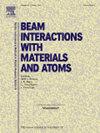Unraveling interaction mechanisms of Kr cavities with Ag in irradiated silicon carbide under high temperatures
IF 1.4
3区 物理与天体物理
Q3 INSTRUMENTS & INSTRUMENTATION
Nuclear Instruments & Methods in Physics Research Section B-beam Interactions With Materials and Atoms
Pub Date : 2025-04-12
DOI:10.1016/j.nimb.2025.165697
引用次数: 0
Abstract
Polycrystalline 3C-SiC was sequentially implanted with 3.0 MeV and 1.2 MeV Kr12+ ions, followed by annealing at 1500 °C to form a double-layer of nanosized Kr cavities. Subsequently, 2.6 MeV Ag19+ ions were implanted into both the Kr-implanted sample and a pristine 3C-SiC sample, followed by annealing at 1500 °C. Experimental results revealed the formation of a Kr-Ag-Kr sandwich structure in the Kr-implanted 3C-SiC after Ag19+ ion implantation. At 1500 °C, Ag atoms exhibited localized diffusion in 3C-SiC, forming nanoscale clusters. Compared to pristine 3C-SiC, the Kr-implanted 3C-SiC showed smaller Ag clusters with a higher distribution density. The independent existence of Kr cavities and Ag clusters was observed, with Ag atoms preferentially diffusing into regions of higher damage. Enhanced diffusivity of Ag atoms was noted in samples containing Kr cavities. This study provides valuable insights into the diffusion behavior of fission product Ag in the SiC layer of TRISO fuel particles.
高温下辐照碳化硅中Kr空腔与Ag相互作用机理的揭示
以3.0 MeV和1.2 MeV的Kr12+离子依次注入多晶3C-SiC,并在1500℃下退火形成双层纳米级Kr空腔。随后,将2.6 MeV Ag19+离子注入到kr注入的样品和原始的3C-SiC样品中,然后在1500℃下退火。实验结果表明,在注入Ag19+离子后,kr注入的3C-SiC中形成了Kr-Ag-Kr夹层结构。在1500℃时,Ag原子在3C-SiC中局部扩散,形成纳米级簇。与原始3C-SiC相比,kr注入的3C-SiC的Ag团簇更小,分布密度更高。观察到Kr空腔和Ag团簇的独立存在,Ag原子优先扩散到损伤较高的区域。在含有Kr空腔的样品中,Ag原子的扩散率增强。本研究对裂变产物Ag在TRISO燃料颗粒SiC层中的扩散行为提供了有价值的见解。
本文章由计算机程序翻译,如有差异,请以英文原文为准。
求助全文
约1分钟内获得全文
求助全文
来源期刊
CiteScore
2.80
自引率
7.70%
发文量
231
审稿时长
1.9 months
期刊介绍:
Section B of Nuclear Instruments and Methods in Physics Research covers all aspects of the interaction of energetic beams with atoms, molecules and aggregate forms of matter. This includes ion beam analysis and ion beam modification of materials as well as basic data of importance for these studies. Topics of general interest include: atomic collisions in solids, particle channelling, all aspects of collision cascades, the modification of materials by energetic beams, ion implantation, irradiation - induced changes in materials, the physics and chemistry of beam interactions and the analysis of materials by all forms of energetic radiation. Modification by ion, laser and electron beams for the study of electronic materials, metals, ceramics, insulators, polymers and other important and new materials systems are included. Related studies, such as the application of ion beam analysis to biological, archaeological and geological samples as well as applications to solve problems in planetary science are also welcome. Energetic beams of interest include atomic and molecular ions, neutrons, positrons and muons, plasmas directed at surfaces, electron and photon beams, including laser treated surfaces and studies of solids by photon radiation from rotating anodes, synchrotrons, etc. In addition, the interaction between various forms of radiation and radiation-induced deposition processes are relevant.

 求助内容:
求助内容: 应助结果提醒方式:
应助结果提醒方式:


